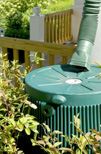- WaterSense
- Outdoor
- Watering Wisely
- Tips for Watering Wisely
Tips for Watering Wisely
Tired of dragging out the hose every day or letting your sprinkler cool off the sidewalk? The following tips can help you water much less—and more wisely.
For the Home
Don't overwater. Learn plants' water needs and water appropriately.
If you step on your lawn and the grass springs back, it does not need to be watered. Watering plants too much and too frequently results in shallow roots, weed growth, disease, fungus, and stormwater runoff. Water your trees and shrubs, which have deep root systems, longer and less frequently than shallow-rooted plants. Check with your Cooperative Extension Service![]() or water utility for advice on watering needs in your area.
or water utility for advice on watering needs in your area.
Water when the time is right.
The best time to water is in the early morning (4 to 7am)—to reduce evaporation—when the sun is low or down, winds are calm, and temperatures are cool. You can lose as much as 30 percent of water to evaporation by watering midday.
 Save it from a rainy day.
Save it from a rainy day.
Saving water from storms is a great way to supplement efficiency measures. Rain barrels or cisterns can be used to harvest rain water for irrigation and other outdoor water uses.
Be creative with alternative water sources.
Use water from the air conditioning condenser, dehumidifier, bath, or sink on plants or in the garden. When using household wastewater, be careful not to use water that contains bleach, automatic-dishwashing detergent or fabric softener. Use properly treated wastewater for irrigation where available.
Sweep driveways, sidewalks and steps rather than hosing them off.
Check your garden hose for leaks at its connection to the spigot. If it leaks while you run your hose, replace the nylon or rubber hose washer and ensure a tight connection to the spigot using pipe tape and a wrench.
Tips for Irrigation Systems
Look for the Label
If you have a standard clock timer controller, consider replacing it with a WaterSense labeled weather-based irrigation controller (WBIC). WaterSense labeled irrigation controllers can help landscapes save water by scheduling irrigation events only when plants really need it.
Adjust your irrigation system with the seasons.
Familiarize yourself with the settings on your irrigation controller and adjust the watering schedule regularly to conform to seasonal weather conditions. A good rule of thumb – when you adjust your thermostat due to seasonal temperature changes, adjust your irrigation controller watering schedule as well.
Set sprinklers to water the lawn or garden only—not the street or sidewalk, because they don't grow!
Play "zone" defense.
Schedule each individual zone in your irrigation system to account for the type of sprinkler, sun or shade exposure, and the soil type for the specific area. The same watering schedule rarely applies to all zones in the system.
 Check for WaterSense!
Check for WaterSense!
A certified irrigation professional can design, install, maintain, or audit your system to ensure optimal efficiency using the proper amount of water to maintain a healthy landscape. Ask if your irrigation contractor is a WaterSense partner, which means he or she has been certified through a program that focuses on water efficiency.
Inspect your irrigation system monthly.
Check for leaks, broken or clogged heads, and other problems, or engage an irrigation professional to regularly check your system. Clean micro-irrigation filters as needed.
Get your head adjusted.
Correct obstructions in sprinkler heads that prevent sprinklers from distributing water evenly. Keep water off pavement and structures.
Flip to a rain shutoff switch.
Rain shutoff switches, required by law in many states, turn off your system in rainy weather and help compensate for natural rainfall. This inexpensive device can be retrofitted to almost any system.
 Use smart technology.
Use smart technology.
Consider installing water-saving technologies such as WaterSense labeled irrigation controllers, soil moisture sensors, efficient sprinkler heads, and micro or drip irrigation.
Install low-volume micro-irrigation for gardens, trees, and shrubs.
Micro-irrigation includes drip (also known as trickle), micro-spray jets, micro-sprinklers, or bubbler irrigation. Micro-irrigation devices irrigate slowly and minimize evaporation, runoff, and overspray. For more information on drip or micro irrigation, see this video![]() on drip irrigation installation from our partners at Cascade Water Alliance.
on drip irrigation installation from our partners at Cascade Water Alliance.










